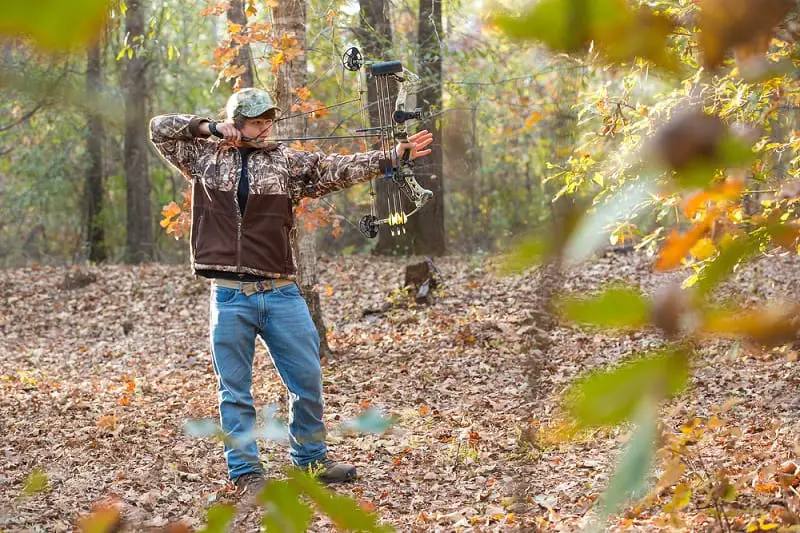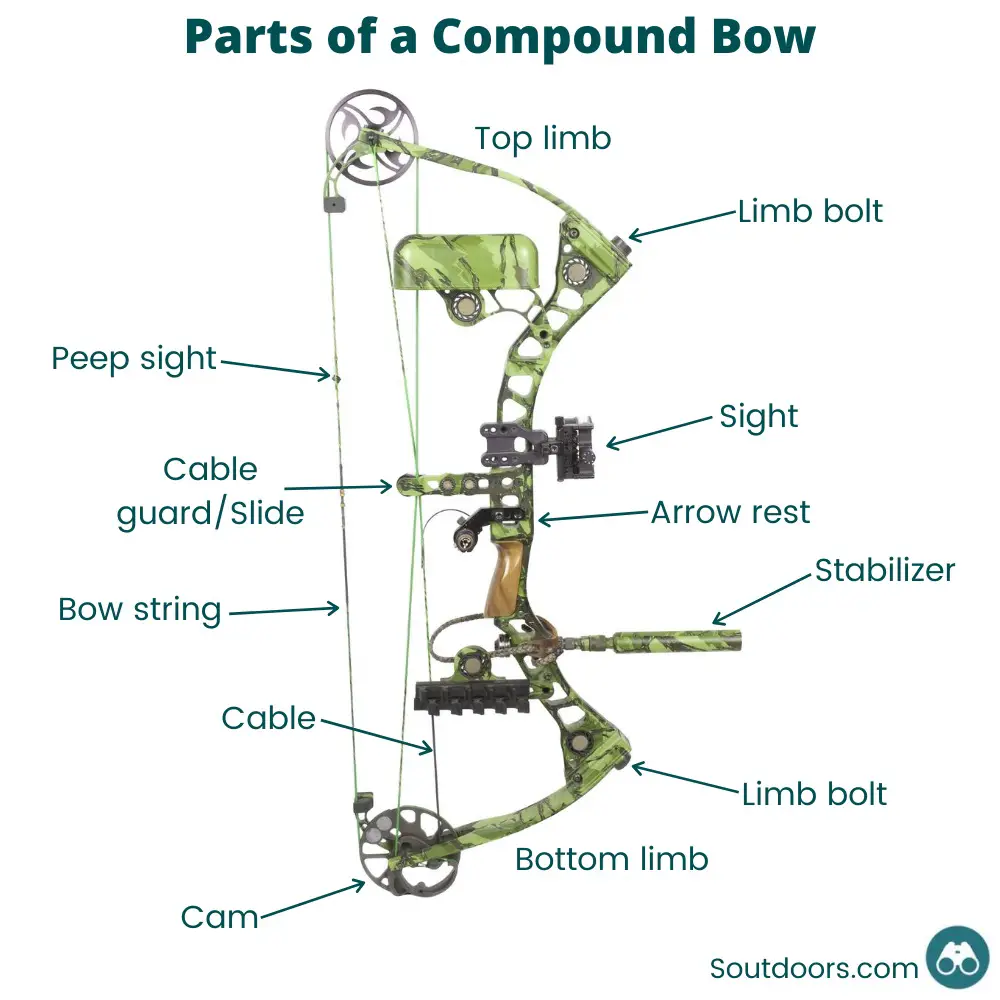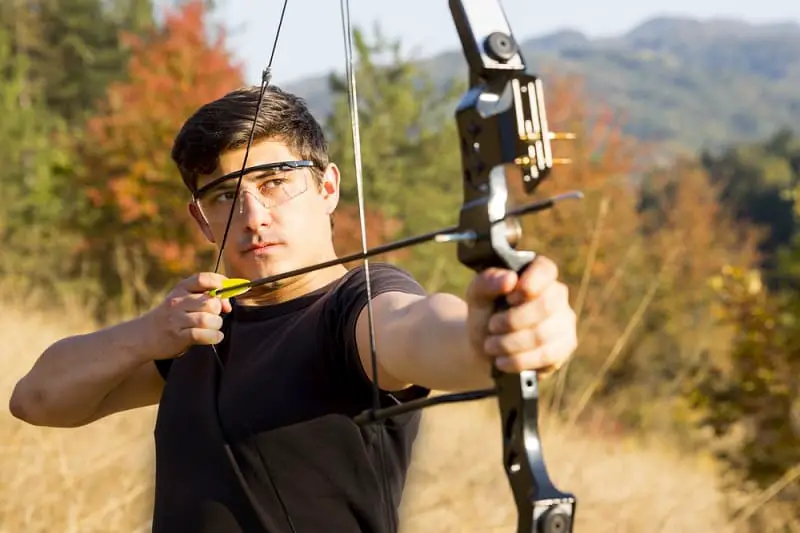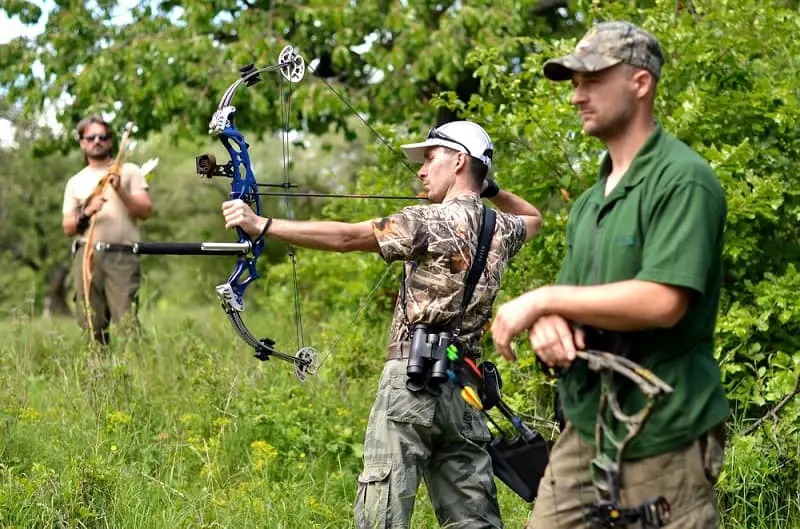
While traditional bows like recurves and longbows are still in use today, compound bows are far more popular. Compound bows use cams and wheel idlers to give archers a mechanical advantage over traditional bows. Because of these special pulleys, a compound bow archer holds just a fraction of the bow’s peak weight at full draw—a pretty big advantage over traditional bows.
So what is a compound bow? Let’s dig in to find out.
The History of the Compound Bow
Recurves and longbows were the weapons of archers for thousands of years. While these bows were simple and straightforward, they could be somewhat bulky. They featured no user-specific adjustability and required a significant amount of physical force to draw them back.
A New Design
In the 1960s, Holless Wilbur Allen began tinkering with a revolutionary new bow. He wanted to create a design with a pulley-like system to enhance shootability. Several efforts, including a block-and-tackle system, proved to be of little use. Eventually, Allen settled upon an eccentric wheel and cam design.
This design proved to be much more efficient than any of Allen’s previous trials, though it was crude by today’s standards. Allen received a patent for the first compound bow in 1969.
Despite having a patent in hand, Allen couldn’t find manufacturers willing to mass-produce his invention and market it to the public. By 1972, Olympus and Carroll Archery Products were the only two compound bow manufacturers in existence. However, that would soon change.
The Model-T Bow
Tom Jennings was the editor for Bowhunting World in the 1960s. Allen set Jennings an early prototype for the compound bow, sparking Jennings’ interest. Jennings quickly licensed production rights for the compound bow from Allen and began designing his own line of mechanically-assisted bows.
This gave rise to Jenning’s innovative Model-T compound bow. It relied on a dual-wheel, tip-to-tip cable design and provided archers with a lightweight and easily-tuned bow. The Model-T was a success, and the compound bow industry began to blossom.
In the ten years that followed the first patent for the compound bow, many archery companies jumped into the production of similar models. PSE, Darton, Hoyt, Bear, Browning, and Martin archery companies had all become mainstays in the compound bow market, and sales continued to skyrocket.
The Modern Bow
Today, the popularity carries on, with compound archery now eclipsing traditional bows as the most popular form of archery. Much of this popularity stems from the many technological and engineering advancements in compound bow design.
Throughout the decades, bows have become lighter, faster, and more forgiving to shoot. In that time, compound bows have changed drastically. In general, axle-to-axle lengths are shorter, parallel limbs are standard, and brace heights increased to retain forgiveness—even from bows with blazing IBO speeds.
The sum of 50 plus years of innovation provides archers with modern compound bows that capable of blistering fast arrow speeds. In turn, bowhunters gain the ability to cleanly harvest game efficiently—the goal of all good hunters.
Check out some of the best new models in our roundup of the best compound bows on the market.
Compound Bow Components
To understand how compound bows work, you have to familiarize yourself with the parts of a compound bow. While the individual components can vary a bit between manufacturers, their function is pretty similar from one to the next.
Riser
Imagine a riser as the heart of a compound bow, to which every other component attaches. It’s the vertical segment where you’ll find the grip. A bow’s limbs attach to their corresponding limb pockets at each end of the riser. They’re almost always aluminum or carbon.
Bow Limbs
A bow’s limbs join the riser at each end, held in place with limb bolts. These bolts can turn clockwise or counterclockwise to set a bow’s draw weight. As a bow’s limb bolts tighten, draw weight increases. Conversely, loosening a bow’s limb bolts will reduce the draw weight.
Cams and Idlers
More than anything else, cams and idlers are what set compound bows apart from the pack. A bow’s cams attach at an axle to the outer end of each limb. As the archer draws the bow, these cams actuate (or flip over), providing a mechanical advantage. This advantage lightens the amount of weight required to hold the bow at full draw. You can find both single cam and dual cam bows.
The buss cables drive the cams, pulling them around on their axles. A bow’s draw length increases or decreases by making adjustments to modules attached to each cam.
Bowstring
A bow’s string attaches to its cams. The archer pulls on the bowstring during the draw cycle. An archer’s arrow attaches to the bowstring at its nocking point. As the archer draws the bow, the pulling force on the bowstring transfers to the bow’s cams, which then actuate with further assistance from the buss cable(s).
Upon releasing the shot, the bowstring shoots forward, and the cams rapidly return to their neutral position. This process releases a substantial amount of stored energy and sends an arrow downrange.
Buss Cable
A buss cable synchronizes a bow’s cams, ensuring that both cams actuate at the same time when shooting.
The number of cables that a bow uses generally depends upon the cam layout. Dual cam bows commonly use two separate cables while single cam bows utilize one cable and an extended bowstring.
Bow Accessories
Outside of their basic components, compound bows also use tons of accessories to create an accurate and fine-shooting bow. Some of the most common accessories include bow sights, peep sights, stabilizers, and wrist slings. Additionally, virtually all compound bows utilize specialty arrow rests, such as the Whisker Biscuit, that mount just above the riser’s natural arrow shelf.
The variety of accessories on a bow usually differ slightly with the archer’s preference and whether it’s a hunting or archery bow.

How A Compound Bow Works
At first glance, compound bows seem complicated to operate, making them somewhat intimidating for new archers. Luckily, they’re more straightforward than they appear.
A basic understanding of how these modern bows function can clear up most misconceptions.
Preparing For The Shot
Before you ever draw a compound bow, you need to nock an arrow. Do this by pressing the nock (the notch in the rear) onto the bowstring at its nocking point. On most modern compound bows, this point will be in between the D-loop. In most cases, you’ll hear an click when the nock pops into place along the bowstring.
Once you nock an arrow, secure it in the bow’s arrow rest. The process for doing so can differ slightly from one type of rest to the next but generally involves centering the arrow into the rest’s point of retention.
With an arrow in place, grasp the bow’s grip with your bow hand, and latch your release aid onto the bowstring’s D-loop. At this point, you will be ready to draw your bow in preparation for the shot.

Drawing Your Bow
Upon pulling your bow’s string rearward, you’ll notice a substantial amount of initial tension. This is normal, as your bow’s cams need to actuate enough to reach “the valley” before the pressure releases.
The valley is a term used to describe the last portion of the draw cycle, where you’ll benefit from the effective let-off value of the bow. Once reaching the valley, you will only have to hold a small percentage of your bow’s peak draw weight.
As you continue through the draw cycle, the bowstring begins to rotate the cam or idler found at the end of each limb. At the same time, the buss cables cycle to help the archer pull the limbs into the fully-drawn position.
The buss cables also synchronize each independent cam or idler pulley’s operation with its counterpart mounted on the opposing limb.
Because a bow’s cams are eccentric in design, you will reach a point approximately ⅔ of the way through the draw cycle where you’ll need less force to complete the rest of your rearward pull.
When you reach this point, your job gets easier. You’ll be able to reach your anchor point with ease as you settle against the bow’s back wall. The back wall is the designated point at which the draw cycle concludes, upon reaching your preset draw length.
Releasing Your Shot
After you reach full draw and settle the appropriate sight pin onto your target, the last order of business left is your release. Slowly squeeze the trigger of your release aid, which will let go of the D-loop, sending the bowstring forward. Then, the arrow shoots forward, guided for a brief moment by the bow’s arrow rest.
Upon releasing the shot, your bow’s cams will begin to actuate again, but in the opposite direction as they are now under pressure. As this pressure releases, lots of stored kinetic energy releases through the bowstring and transfers to the arrow. At the same time, the buss cables are also returning to their neutral position at an identical rate of speed as the bowstring and cams.
As an arrow speeds past the bow’s riser, the sudden change in inertia causes bowing and distortion in the arrow. However, the fletchings or vanes glued to the rear cause it to spin rapidly, much like a football as it sails through the air. This spinning motion stabilizes the arrow’s flight and allows it to reach a downrange target.

Benefits of Shooting a Compound Bow
If you are still on the fence about which type of bow to purchase or weighing the pros and cons of compound bow use, you’ll find the following information helpful.
The following is a breakdown of the most frequently cited advantages of compound bow use.
Enhanced Performance
Compared to traditional bows, compound bows are better performers. They’re lightyears ahead in speed. Many modern compound bows feature IBO speed ratings over 330 FPS (feet per second), with some even reaching or breaking the 350 FPS mark. Conversely, any recurve bow capable of breaching the 200 FPS barrier is regarded as lightning fast.
This additional speed presents a flatter arrow trajectory for archers to work with. The flatter trajectory minimizes the effects of a misaligned shot, should the distance be slightly off. This additional speed also serves to reduce the occurrence of “string jump” when hunting. String jump occurs when a deer instinctually reacts to the sound of the bowstring’s release, and in turn, ducks below an arrow.
Adjustability Range
Another wonderful characteristic of modern compound bows is their range of adjustability. A common worry of new archers is choosing a bow that fits well, and that they can shoot without any form of fitment issues. Standard compound bows from nearly every manufacturer feature a minimum of 10-pounds of draw weight adjustability and five to six inches of draw length adjustment.
While this is typically enough adjustability for any archer, there has been a recent push to develop the ultimate “one size fits all” bow. This has led to the release of many extremely adjustable compound bows. Many of these bows, such as the Bear Cruzer G2, feature draw weight adjustability that range as much as 50 or more pounds. Draw lengths often range for more than 15 inches of adjustment.
Youth archers can now select a highly adjustable beginner compound bow that will “grow” with them into adulthood. A new archer with particular sizing requirements can now spend less time pouring over bow specs to find a model that meets their needs. Instead, they can choose from a host of wonderful bows that offer enhanced adjustability.
Let-Off Value
When push comes to shove, drawing a bow is more difficult for some than others. For those who struggle with shooting a traditional bow, such as youths or older folks, a compound bow can be the perfect compromise.
Compound bows benefit from let-off due to the eccentric cam design. This effective let-off means that an archer has to hold only a small percentage of a bow’s peak draw weight when resting at full draw.
Let-off values differ significantly from one bow to the next, but values in the range of 70 to 85 percent are typical. In recent years, several manufacturers have begun to offer compound bows that feature adjustable let-off values, with the highest of these settings offering 90 percent let-off.
To put this in perspective, a bow with a 70-pound draw weight and 90 percent let-off value would leave an archer holding only 7 pounds of weight at full draw.
Compact Design
Another reason for compound bow dominance in the modern archery market is the compact design. Before compound bows, many archers used recurve bows for both hunting and target practice.
Most recurve bows measure in between 58 and 62 inches, tip-to-tip. By comparison, most compound bows measure 30 to 35 inches, axle-to-axle. By comparison, a compound bow, which shoots faster and more accurately, also measures half the size of a recurve.
While bow length might not be a major concern when target shooting, it can be a huge deal in the woods. A recurve can be cumbersome and awkward in the blind or stand, limiting shot opportunities. On the other hand, a compound bow is easy to maneuver and won’t hold you back.
Greater Consistency
The very design of the compound bow makes consistency a reality—a key component to real accuracy. Much of this additional consistency is related to the fact that an archer can’t overdraw a compound bow like a recurve or longbow. When a compound bow has hit the end of its draw cycle, it reaches what is known as the back wall. At this point, all rearward motion of the bowstring stops.
Save for a bit of string stretch, the back wall doesn’t change.
Traditional bows don’t have back walls, which can allow archers to overdraw their anchor points. It can also create more kinetic energy in the bow, completely throwing the arrow’s flight off of the usual course. It can also lead to all-around bad form.
A compound bow solves this issue, promoting consistency and accuracy.
Functional Accessories
Many archers also value compound bows for their range of accessories. For today’s compound archers, there is no true end to how they can customize a bow. A simple ten-minute internet search will reveal thousands of arrow rests, bow sights, stabilizers, quivers, and slings for purchase by anyone looking to enhance their bow’s functionality and aesthetic.
Much like customizing a vehicle, outfitting a bow with several products that you feel to be of value can be an exciting endeavor. While it’s true that there are some accessories available for traditional bows, the selection is often scarce and highly-dependent upon which particular model of bow you own.
Final Thoughts
Simply put, a compound bow is the modern evolution of an age-old design. The advances in materials, engineering, and technology have allowed manufacturers to create deadly accurate bows that are easy to shoot. While it’s fair to say that a bow with wheels and pulleys that provide a mechanical advantage is a compound bow, the reality is that they’re so much more.
